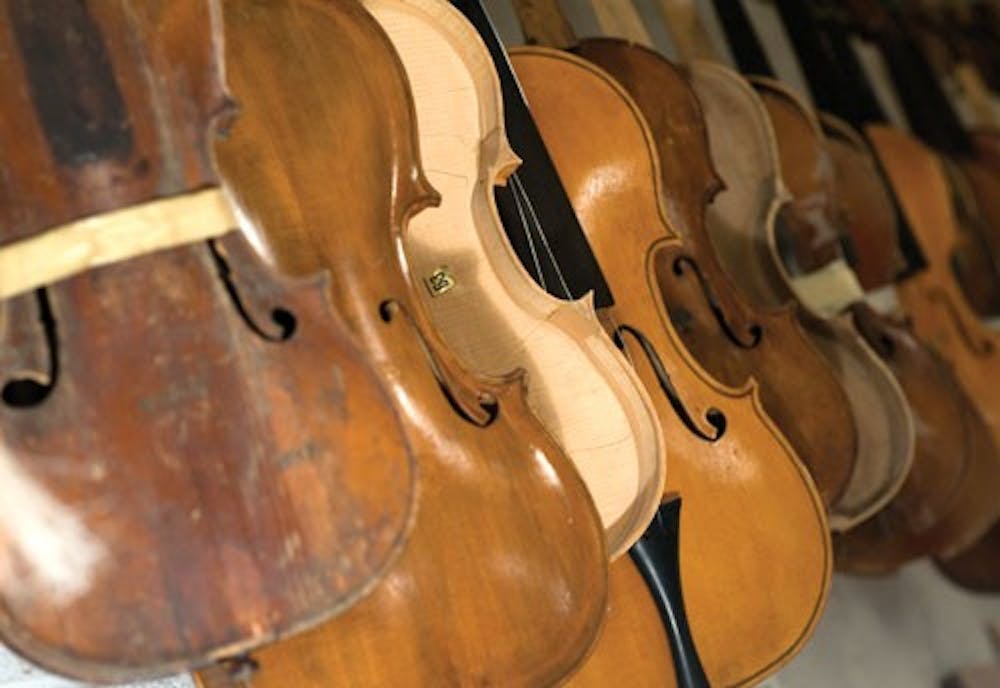IU professor of String Technology Tom Sparks was 14 when he took apart his mother’s 18th century violin with a kitchen knife. He wanted to know how it worked, and naturally tried to find out for himself.\nSparks recalls the ordeal as a valuable, though costly, learning experience. \n“It was a Guarneri violin, which today would be valued from $200,000 to $800,000,” Sparks said. “I was surprised when I found that there was nothing inside.”\nSparks’ seemingly juvenile experiment was an amusing precursor to his life’s work. It was only after deconstructing his mother’s prized violin that he would begin learning the art of violin making. And unlike the violin itself, Sparks would find the world of lutherie, or violin making, to be anything but empty. \nSparks has worked in the IU Violin Shop since 1977, when he was a member of the shop’s first graduating class. He has long since become the director and sole professor of the program. An accredited program since 1978, the IU Violin Shop stands alone as the only one of its kind in the world. \nSo why then doesn’t anyone know about it?\n“We are one of the few arts programs that are constantly running in the black,” Sparks said. “I found out years ago that if you’re not asking the University for money than they forget that you are here.”\nSophomore Travis Davies has only just started learning in the shop, and is already convinced that it is his most valuable class.\n“I’ve learned more here in six weeks than I did in the entirety of last year,” Davies said. “You always can learn more about things you enjoy.”\nThe students make their violins exclusively by hand and the quality of their work draws praise from musicians far and wide. Sparks jokes that the shop is on the cutting edge of 18th century technology. Although the old wooden work benches and violin-adorned walls do evoke images of yes teryear, the shop continues to help students learn a craft that is still very much in demand.\n“Excluding the past two years, 95 percent of the graduating class from this class not only immediately received jobs, but are still working in the field,” Sparks said.\nSparks’ students are driven by the fruits of their labor. For many, the two years spent in the shop represents the rainbow leading to a hard-earned pot of gold. The shop’s jovial mood lets students smile through the arduous process of making a violin. Patience and a light heart are essential for success in the shop.\n“We have a lot of inside humor up here that most people don’t get,” said assistant instructor and IU junior Tierney McGuire. \nComic relief is always appreciated since students sometimes work on thumbnail-sized parts for up to an hour at a time, a process that can become tedious.\n“If you’re not patient, it can be very frustrating,” said Rebecca French, an assistant instructor.\nStudent-made violins are selling from $3,500 to as much as $10,000. However, it is the acquisition of this time-honored craft that ultimately proves to be priceless.\nIn the age of McDonald’s and instant gratification, Sparks said students sometimes expect to learn the secrets of the trade in two years. This is not the case, as there are centuries of craftsmanship and tradition to be learned. Students usually finish their first violins after their fourth semester in the shop. To say that many become attached to their instruments is an understatement. \n“When they finish their violins, you can see that they are just about ready to cry,” Sparks said. “It takes us so long to get that first violin together, and any mistake along the line can just be brutal for you.”\nThe completion of their project is so momentous that students throw a birthday party whenever a violin is finished. Emotions run high as the shop celebrates the birth of a violin, and more importantly, a violin maker.\nThe IU Violin Shop has educated hundreds of successful luthiers, which has allowed the little known program to become a reputable source of new hands in a centuries-old craft.
Workshop of wonder

Get stories like this in your inbox
Subscribe





